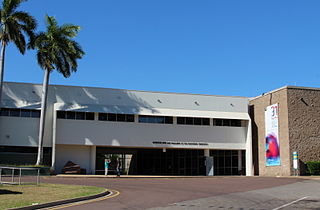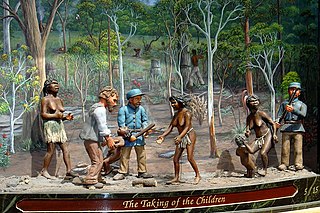
Torres Strait Islanders ( ) are the indigenous people of the Torres Strait Islands, part of Queensland, Australia. They are distinct from the Aboriginal people of the rest of Australia, and are generally referred to separately. There are also two Torres Strait Islander communities on the nearby coast of the mainland at Bamaga and Seisia.

Museology or museum studies is the study of museums. It explores the history of museums and their role in society, as well as the activities they engage in, including curating, preservation, public programming, and education.
Theodor George Henry Strehlow was an anthropologist who studied the Arrernte Aboriginal Australians in Central Australia. He was considered a member of the Arrernte people, by dint of his ritual adoption by the tribe. He married twice, to Bertha James, in Prospect, South Australia, on 21 December 1935, with whom he had three children, Theo, Shirley and John, and to Kathleen Stuart in 1972, with whom he had a son, Carl.

The Araluen Cultural Precinct, formerly the Araluen Centre for Arts & Entertainment, in Alice Springs in the Northern Territory of Australia, is a cultural centre incorporating museums and a theatre.

The State Library of Queensland is the main reference and research library provided to the people of the State of Queensland, Australia, by the state government. Its legislative basis is provided by the Queensland Libraries Act 1988. It contains a significant portion of Queensland's documentary heritage, major reference and research collections, and is an advocate of and partner with public libraries across Queensland. The library is at Kurilpa Point, within the Queensland Cultural Centre on the Brisbane River at South Bank.
The Western Australian Museum is the state museum for Western Australia. It has six main sites: in Perth within the Perth Cultural Centre, two in Fremantle, and one each in Albany, Geraldton, and Kalgoorlie-Boulder. The Western Australian Museum is a statutory authority within the Culture and the Arts Portfolio, established under the Museum Act 1969.
Yirrkala is an indigenous community in East Arnhem Shire, Northern Territory of Australia. It is 18 km South-East from the large mining town of Nhulunbuy in Arnhem Land. In the 2016 census, Yirrkala had a population of 809 people.
Carl Friedrich Theodor Strehlow was an anthropologist, and genealogist that served on two Lutheran missions in inland Australia from May 1892 to October 1922, a total of thirty years. He was at the first mission station, Killalpaninna, from 1892 to 1894, and the second, Hermannsburg, eighty miles west of Alice Springs, from 1894 to 1922, first as teacher and, from 1901 onwards, manager, and it is for his work here that he is mostly known today. Strehlow was ably assisted and supported by his wife Friederike Johanna Henriette Keysser, who played the central role in reducing the high infant mortality which threatened Aboriginal communities all over Australia after the onset of white settlement. It is probable that Hermannsburg was the only Mission in Australia at the start of the twentieth century where the population was growing through natural increase. As a polymath with an interest in natural history, through his Aranda informants Strehlow provided plant and animal specimens to museums in Germany and Australia, a number of which first came to scientific notice through his collecting. This was the outcome of his collaboration with Moritz, Baron von Leonhardi of Gross Karben in Hessen, Germany, who also suggested he write his monumental anthropological work Die Aranda- und Loritja-Stämme in Zentral-Australien. With Leonhardi as editor this work became the first publication of the newly founded Städtisches Völkermuseum of Frankfurt am Main, appearing in eight parts between 1907 and 1920. Strehlow sent what was said to be the best collection in the world of Aboriginal artefacts – both sacred and secular – to Frankfurt, unfortunately largely destroyed in the bombing of the city in World War Two, though some fine pieces remain. Due to Leonhardi's sudden death in 1910, Strehlow's linguistic researches intended as part of Die Aranda- und Loritja-Stämme were never published, though used in manuscript form by his son Theodor George Henry Strehlow and later Hermannsburg missionaries. Strehlow also collaborated on the pioneering first complete translation of the New Testament into an Aboriginal language (Dieri), published by the British and Foreign Bible Society in 1897, and he later translated the New Testament into Aranda, parts of which were published after his death. He also produced a reader and service book in the latter language. Falling ill with dropsy in September 1922, he tried to reach a doctor but died at Horseshoe Bend halfway between Alice Springs and Oodnadatta, leaving Frieda and fourteen-year-old son Theodor to continue south to Adelaide without him. Professor TGH Strehlow, who is better known than Carl, built his scholarly career in part on the researches carried out by his father.

The Art Gallery of Western Australia (AGWA) is a public State art gallery that is part of the Perth Cultural Centre, in Perth, Western Australia. It is located near the Western Australian Museum and State Library of Western Australia and is supported and managed by the WA Government Department of Local Government, Sport and Cultural Industries. The current gallery main building opened in 1979 and will celebrate its 40th anniversary in 2019. It is linked to the old court house – The Centenary Galleries — which house the historical collection. 2020 is the 125th anniversary of the foundation of the institution.[1]

The Arrernte people, sometimes referred to as the Aranda, Arunta, or Arrarnta are an Aboriginal Australian people who live in the Arrernte lands, at Mparntwe and surrounding areas of the Central Australia region of the Northern Territory. Some Aranda live in other areas far from their homeland, including the major Australian cities and overseas.
The Alice Springs Public Library is a free public library service in Australia. While the library provides traditional library services to the community of Alice Springs, it also supplies a unique distance service to the remote people of Central Australia. While officially named the Nevil Shute Memorial Library, the name is little used.

The Uganda Museum is located in Kampala, Uganda. It displays and exhibits ethnological, natural-historical and traditional life collections of Uganda's cultural heritage. It was founded in 1908, after Governor George Wilson called for "all articles of interest" on Uganda to be procured. Among the collections in the Uganda Museum are playable musical instruments, hunting equipment, weaponry, archaeology and entomology.
Norah Nelson Napaljarri is a Warlpiri-speaking Indigenous artist from Australia's Western Desert region. Norah Nelson began painting in 1986 and has exhibited her works both in Australia and other countries. Her paintings and pottery are held in the collection of the National Gallery of Victoria.
Contemporary Indigenous Australian art is the modern art work produced by indigenous Australians. It is generally regarded as beginning in 1971 with a painting movement that started at Papunya, northwest of Alice Springs, Northern Territory, involving artists such as Clifford Possum Tjapaltjarri and Kaapa Tjampitjinpa, and facilitated by white Australian teacher and art worker Geoffrey Bardon. The movement spawned widespread interest across rural and remote Aboriginal Australia in creating art, while contemporary indigenous art of a different nature also emerged in urban centres; together they have become central to Australian art. Indigenous art centres have fostered the emergence of the contemporary art movement, and as of 2010 were estimated to represent over 5000 artists, mostly in Australia's north and west.
Kaapa Mbitjana Tjampitjinpa was a contemporary Indigenous Australian artist of Anmatyerre, Warlpiri and Arrernte heritage. One of the earliest and most significant artists at Papunya in Australia's Northern Territory in the early 1970s, he was a founding member and inaugural chairman of the Papunya Tula artists company, and pivotal to the establishment of modern Indigenous Australian painting.
Richard “Dick” Glyn Kimber AM is an Australian historian and author who has written extensively on the history, art, culture and wildlife of Central Australia. He has published several books, the best known of which is Man From Arltunga: Walter Smith, Australian Bushman as well as more than 100 articles and essays.
Dr Lissant Bolton is an Australian anthropologist and the Keeper of the Department of Africa, Oceania and the Americas at the British Museum. She is particularly known for her work on Vanuatu, textiles, and museums and indigenous communities.
The Kukatja, also frequently referred to as Loritja, are an indigenous Australian people of the Northern Territory. They are not to be confused with the Kokatja of Western Australia, the Kokatja of South Australia, nor with the Kukatja of Queensland.
Tjapartji Kanytjuri Bates was an Australian Ngaanyatjarra Aboriginal artist based in Warakurna, Wanarn, and Warburton communities in the Gibson Desert. Known to be active from 1991, her work incorporates media of paint, canvas, glass and felt, and is particularly centred around interpretations of Tjukurrpa from her mother and father. Bates was a prolific artist and her work has been shown in over 20 exhibitions, as well as the National Gallery of Victoria and the National Gallery of Australia.











